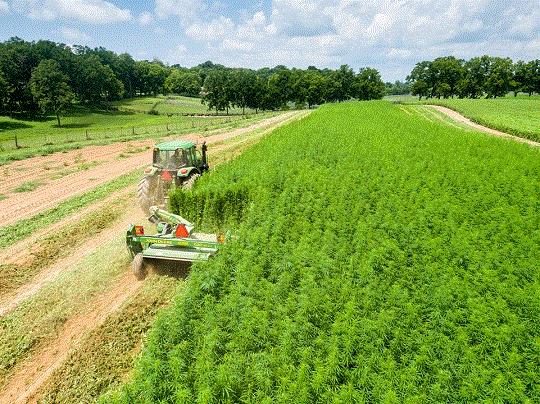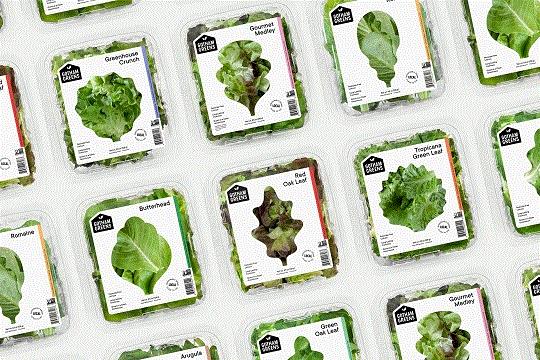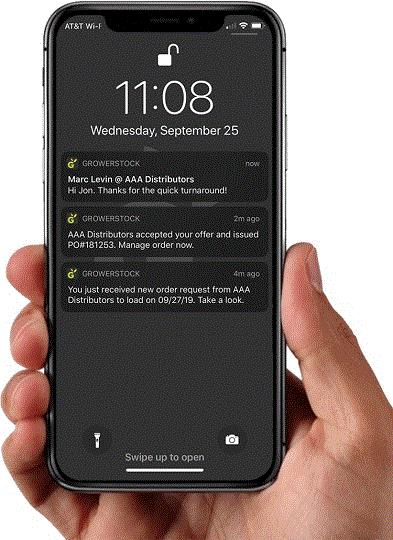New USDA Hemp Rules
At the tail end of October, the USDA released its long-awaited rules for U.S. domestic hemp production, ironically calling it an "interim final rule" (in the immortal words of Inigo Montoya: “I do not think that word means what you think it means”).
The reason it’s an interim final rule is because it's been published in the Federal Register and public comments will be taken until December 30, 2019. The current rule will be effective October 31, 2019 through November 1, 2021. Any comments received before that December 30 deadline will be taken into account before making the final-final ruling. Make sense?
You can read the full 161-page interim final rule HERE.
It’s an awful lot to digest, so I turned to our resident cannabis and hemp expert Brian Corr, who's a consultant in the industry and writes a quarterly column for GrowerTalks, for a CliffsNotes version and his thoughts.
“My takeaway: There is nothing in this rule that is a game-changer, but it is very helpful in clarifying some things that were vague. Probably the most significant topic was related to testing. Detailed testing information is included. One of the most important things added was clarification about accuracy of testing. Because of the 0.3% definition determining what is allowable hemp and what is prohibited marijuana, a grower could lose the whole value of a crop based on one-hundredth of a percent difference in a test. This ruling requires testing labs to include a measure of uncertainty in the test results. So if a test comes back at 0.310 but the measure of uncertainty is plus or minus 0.02%, that sample does not fail because the test is not accurate enough to know if the sample was above or below 0.3%.
“It is important to remember that even though this is called a ‘final’ rule, it is an interim final rule. First, there may be some small changes before it is published in the Federal Register and becomes official. More importantly, it is a rule for only two years. The final final rule is scheduled for then. Two calendar years is forever in cannabis years, so there is no way to know what things will be like then either in the industry or in policy.”
I also clarified with Brian that this doesn’t touch anything related to FDA regulations, which could still happen related to CBD products. He affirmed that: “FDA is specifically allowed to set their own regs, which have not been developed other than the requirement for the boilerplate message.”
That boilerplate message is that the product’s efficacy has not been officially evaluated. So those who are looking into hemp for the CBD product aspect still await more regulation.

Photo Credit: Matt Barton.University of Matt Barton, University of Kentucky Ag CommunicationsMatt Matt Barton, University of Kentucky Ag Communications
Meanwhile, those who are looking into hemp for industrial purposes can find out more at this year’s Western Trade Show & Seminars, where Dr. Jason Griffin from Kansas State University will present “Can Industrial Hemp Fit into Your Nursery Operation?”
Here’s the program description: “Industrial hemp was the talk of the region in 2019, as states hurried to implement pilot research programs. Whether for grain, fiber or the essential oils, everyone was inquiring about industrial hemp. The KState John C. Pair Horticultural Center grows hemp for all three end products. Dr. Griffin and the staff evaluated two dozen varieties in 2019. Jason will discuss those results, along with many of the lessons learned as a first-year hemp grower.”

Go West, Gotham Greens
That’s exactly what the folks at Gotham Greens are doing as they prepare to open a 30,000-sq. ft. greenhouse in Aurora, Colorado, east of Denver. The site is expected to open in 2020 to supply retailers, restaurants and food service customers in the Mountain West, according to the company.
The greenhouse is strategically located adjacent to Stanley Marketplace, a food hall and urban market with more than 50 vendors. “Once open, the greenhouse also will serve as a resource to educate local residents and visitors on the benefits of sustainable, indoor farming,” the website states.

A sampling of the products Gotham Greens offers.
According to a recent story in the Denver Post, the facility will grow arugula, basil, bok choy, and other herbs and leafy greens. CEO Viraj Puri told the newspaper Whole Foods has already committed to carrying Gotham Greens lettuce mixes, herbal dressings and other products in its Colorado stores. You can read the full story HERE.
The Denver site makes eight for Gotham Greens, with a new, 100,000-sq. ft. greenhouse in Providence, Rhode Island opening this fall and a 100,000-sq. ft. greenhouse opening in Baltimore, Maryland, this winter.

Ag Labor Reform Bill Introduced
More action happened at the end of October with a new ag labor bill introduced in the House, too. Our editor with the ear to the D.C. ground, Jen Zurko, provided this report:
Just in case you thought Congress was only working on impeachment proceedings, on October 30, House lawmakers introduced a bipartisan, comprehensive and highly anticipated agricultural labor reform bill. Called the Farm Workforce Modernization Act, the bill’s intention is to address labor challenges head-on, with solutions that stabilize the current agricultural and horticultural workforce, improve the legal channels for future seasonal and permanent workers in the farming sector, and advance integrity in the hiring process.
The core group of negotiators, led by Judiciary Subcommittee on Immigration and Citizenship chairwoman Zoe Lofgren (D-CA), also included Rep. Jimmy Panetta (D-CA) and Republicans Dan Newhouse (WA), Mike Simpson (ID), Mario Diaz-Balart (FL) and Doug LaMalfa (CA).
The bill features three titles:
-
Title I focuses on stabilizing the current, but unauthorized, farm workforce—it provides three different options for workers to transition to legal status
-
Title II modifies the current H-2A agricultural worker visa program
-
Title III phases in a requirement for agricultural employers to use the electronic employment eligibility system known as E-Verify for new hires
"AmericanHort congratulates our House champions on today’s introduction,” Craig Regelbrugge, Senior VP of Government Relations & Research for AmericanHort, said in a statement. “This bipartisan compromise advances an important debate and provides a platform for serious consideration of urgently needed reforms addressing the agricultural sector and farm employees.”
As is typically the case in a complex bipartisan legislative negotiation, both sides have had to make significant concessions. Most of the agricultural organizations involved in negotiations and in the Agricultural Workforce Coalition, including AmericanHort, are supporting the legislation in order to advance the legislative process in the House, which Democrats control. Craig and his team will seek targeted improvements, especially in Title II, as the legislative process moves forward. If the Republican-controlled Senate can be persuaded to take up legislation, Craig believes that bill provisions that fall short of our industry’s goals can be improved further.
On September 24, AmericanHort filed official comments on the Administration’s “notice of proposed rulemaking” (NPRM) that seeks to streamline and modernize the H-2A agricultural worker visa program. The comments describe in detail where the organization believes the proposed changes would improve the current program and where the Administration misses the mark or could go further.
“What happens on the farm doesn’t stay on the farm; the work contributions of each farm worker create and sustain two to three job opportunities in the surrounding economy,” said Craig. “Rural areas across the country benefit from the jobs and economic opportunity that farm workers create, so long as we are growing and producing labor-intensive crops and commodities here in America. We urge both the House and Senate to move swiftly to advance and improve upon this important legislative foundation."
(Contributing: Craig Regelbrugge)
Question: What do you think of the bill as introduced? Email me at jpolanz@ballpublishing.com.

IR-4 Research Projects
It’s not always sexy, but the IR-4 Project has helped growers for decades by providing the research data that supports pest control labels for specialty agriculture crops, both for pesticides and biopesticides. It continues that mission today (it was originally started in 1963) with a new round of research designed to help a wide variety of specialty crops, including indoor vegetables and leafy greens. I found a list of the research being considered in THIS story from MSU Extension.
I also found lots of useful information on the IR-4 Project website itself, including THIS link to its newsletters. On the IR-4 website you can submit a request for further research, as well.
There's an App For That
It seems like there’s always an app for just about everything we need to do in our daily life. Now, you can add produce procurement to that list. Marc Levin, co-founder of Growerstock, reached out to me recently to highlight the company’s new app, which gives buyers and sellers the ability to trade, track and communicate securely from anywhere. It complements the online platform that currently exists and right now is available on Apple’s App Store, with an Android Google Play version coming soon.
I asked him if this had applications in the controlled environment ag world as well as field grown produce and here’s his response: “Yes, by all means. Our platform works for both field-grown and greenhouse growers. We've also done work with growers with vertical farming solutions.”

According to information provided by the company, their mission is to optimize the open-market sales pipeline so produce buyers and sellers of all sizes can expedite trade in a safe and secure environment.




As always, feel free to email me at jpolanz@ballpublishing.com with comments, questions, news and views.
Until next time,

Jennifer Polanz
Editor-at-Large
Inside Grower
This email received by 23,874 loyal readers!
Interested in advertising in Inside Grower? Contact Paul Black or Kim Brown and they'll show you how easy, effective and affordable it is.